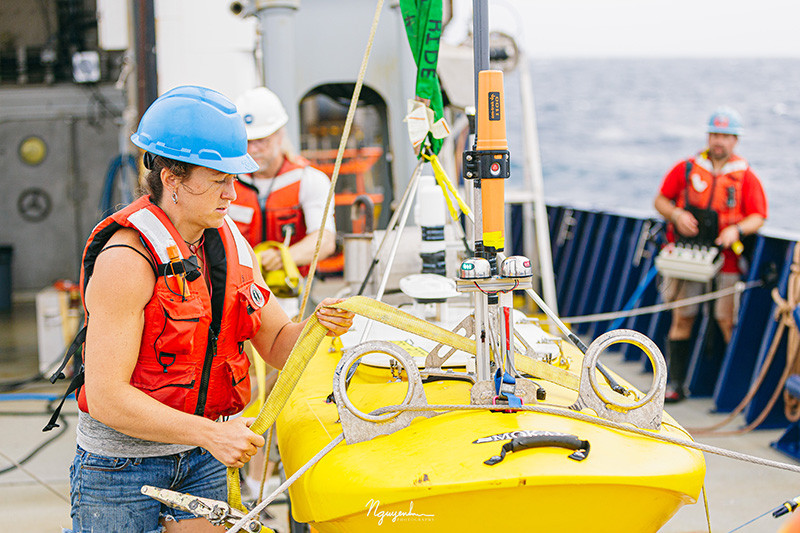Breadcrumb
- Education
- Doctoral Programs
- Program Areas
- Physical Oceanography (PO)
Physical Oceanography (PO)
Interested in applying to our MS or PhD programs? View presentations from this year's info sessions.

Information for the Physical Oceanography PhD program and Master's degree programs
Physical Oceanography is the field of study that deals with mechanisms of energy transfer through the sea and across its boundaries, and with the physical interactions of the sea with its surroundings, especially including the influence of the seas on the climate of the atmosphere. Research activities within this curricular group are both observational and theoretical and include:
- Study of the general circulations of the oceans, including the relations of ocean currents to driving forces and constraints of the ocean basins
- Fluctuations of currents, and the transport of properties
- The mechanisms of transport of energy, momentum, and physical substances within the sea and across its boundaries
- Properties of wind waves, internal waves, tsunami, and planetary waves
- The thermodynamic description of the sea as a system not in equilibrium
- Optical and acoustic properties of the sea
- The influence of surf on near-shore currents and the transport of sediments
Requirements for Admission
In addition to the general requirements for admission to the PhD program listed here, a major in a physical science, including three years of physics and mathematics, is required.
PO APPLICANT EVALUATION CRITERIA
Factors which we use to evaluate applicants include, but are not limited to, (1) Academic Preparation; (2) Scholarly potential; (3) Diversity, equity, and inclusion contributions; (4) Alignment with the program; (5) Motivation and maturity.
Applicants should ensure that they represent themselves accurately with the best possible information in all of the above areas. The admissions committee will consider all aspects of the application including the statement of purpose, transcripts, balance of coursework, letters of recommendation, and responses to optional questions about additional experiences. GRE scores may be included if you wish, and may serve as part of our holistic review, but they are not required.
For full consideration, please submit applications by December 7th. Applications submitted after the deadline may be considered on a case-by-case basis.
Program of Study for PhD
The physical oceanography curriculum combines a comprehensive program of course work with individually tailored specialization to meet student needs. At the start of each quarter during the first year, the guidance committee meets with students to discuss course work and their individual research interests. For example, students might choose to focus on observational physical oceanography, theoretical physical oceanography, or atmosphere/ocean/cryosphere/shoreline interactions.
Students in all areas of physical oceanography are required to take SIOC 210, SIOC 203A-B, SIOC 211A, SIOC 214A, and SIOC 212A, and SIOC 221A-B. Eight additional four-unit graduate courses are required to meet the PhD requirement. Students normally take a total of twelve four-unit graduate courses in the first year (the eight required plus four additional four-unit courses) and at least four additional four-unit courses after the first year. For PhD students who apply to receive an MS, a total of nine four-unit courses are required (see MS requirements).
PhD course work should include a breadth component of two or more four-unit courses in other scientific disciplines. These might come from the Scripps Department core courses in other oceanographic disciplines (SIOG 240, SIOG 260, SIOB 280) or from related graduate-level courses taught at UC San Diego. Exceptions to the above requirements may be granted with written approval by the curricular group coordinator in consultation with the guidance committee and the PO curricular group coordinator.
The Scripps Department offers regular seminars in several areas of current interest. After the departmental exam, students in residence are encouraged to enroll for credit in at least one one-unit seminar each quarter.
Program of Study for MS
The physical oceanography curriculum combines a comprehensive program of course work with individually tailored specialization to meet student needs.
Required course work (20 units selected from the following designated courses):
- SIOC 203A and SIOC 203B. Introduction to Applied Mathematics I-II (4 units each)
- SIOC 210. Physical Oceanography (4 units)
- SIOC 212A and SIOC 212B. Geophysical Fluid Dynamics I-II (4 units each)
- SIOC 214A. Introduction to Fluid Mechanics (4 units)
- SIOC 221A and SIOC 221B. Analysis of Physical Oceanographic Data A-B (4 units each)
Elective course work:
Students may fulfill the remaining units of required course work through elective course offerings selected in consultation with the students’ guidance committee. These might come from the Scripps Institution of Oceanography core courses in other oceanographic disciplines (SIOG 240 Marine Geology; SIOG 260 Marine Chemistry; SIOB 280 Biological Oceanography) or from related graduate-level courses taught at UC San Diego.
Research in Physical Oceanography
Physical Oceanography Faculty and Researchers:
- Matthew Alford
- Laurence Armi
- Janet Becker
- Luca Centurioni
- Paola Cessi
- Teri Chereskin
- Bruce Cornuelle
- Ian Eisenman
- Falk Feddersen
- Peter Gerstoft
- Sarah Giddings
- Sarah Gille
- Xuanting Hao
- Shaun Johnston
- Drew Lucas
- Jennifer Mackinnon
- Matthew Mazloff
- Julie McClean
- Mark Merrifield
- Sarah Purkey
- Ram Ramanathan
- Katharine Ricke
- Dean Roemmich
- Daniel Rudnick
- Uwe Send
- Lia Siegelman
- Jerry Smith
- Janet Sprintall
- Fiammetta Straneo
- Lynne Talley
- Eric Terrill
- Amy Waterhouse
- Kraig Winters
- Shang-Ping Xie
- Nathalie Zilberman